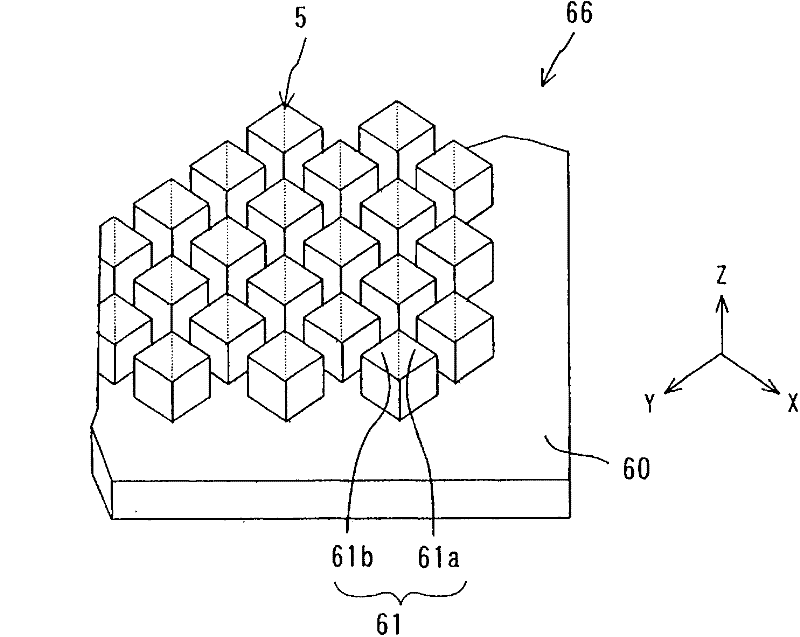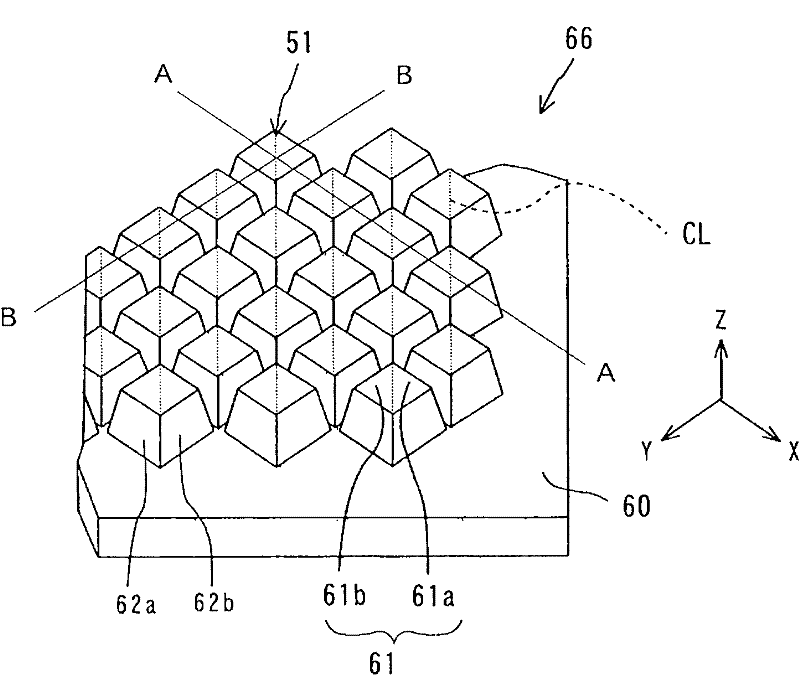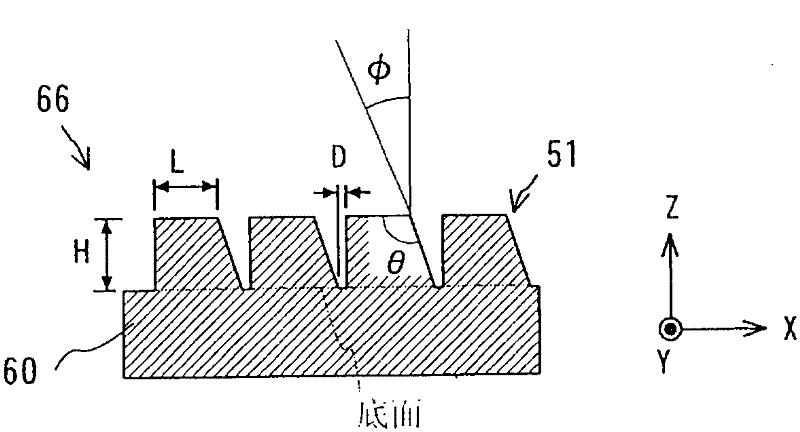Dihedral corner reflector array optical element and method for fabricating the same and display device using the same
A technology of dihedral reflectors and optical elements, applied in the direction of optical elements, optical elements, optics, etc., can solve problems such as damage, real image deformation, and inability to form real images, so as to reduce frictional resistance, reduce scratch damage, Reduce the effect of transmitted light
- Summary
- Abstract
- Description
- Claims
- Application Information
AI Technical Summary
Problems solved by technology
Method used
Image
Examples
Embodiment 1
[0066]As Example 1, in order to improve the transferability of the molding operation, the molten resin is injected into the cavity of the molding die while the stamper (first molding die) is kept at a temperature higher than a predetermined temperature, and then the After the cavity is filled with resin, the mold is cooled at another temperature lower than the predetermined temperature, so that the molded dihedral reflector array optical element is separated from the first and second molds.
[0067] First, if Figure 8A As shown, the predetermined stamper 101 and the second molding die 102 having a flat surface are clamped to be in close contact with each other, and the molding die is kept at a temperature higher than the softening temperature of the resin (for example, 200°, due to acrylic resin) by heating. The softening temperature is about 100°). A heating device SH for heating the stamper and a cooling device SC for cooling the stamper are built in the stamper 101 used i...
Embodiment 2
[0080] As Example 2, in order to improve the release property, the molding device is operated so that at least one of the second molding die 102 and the press die 101 moves relatively in the release direction R, and the formed dihedral corner reflector The arrayed optical element is separated from the first and second molding dies.
[0081] First, if Figure 13A As shown, a predetermined stamper 101 and a second molding die 102 having a flat surface are clamped against each other, and then they are heated to a temperature higher than the softening temperature of the resin to be injected (for example, in the case of using an acrylic resin). is 200°).
[0082] Then, if Figure 13B As shown, the molten resin 104 is injected into the cavity between the die 101 and the second molding die 102 through the gate portion 103 of the molding die by using high pressure.
[0083] Then, if Figure 13C As shown, after the resin 104 is injected, the stamper 101 and the second molding die 1...
Embodiment 3
[0089] Regarding the method shown in FIG. 13, there may be a problem that it is difficult for the second molding die 102 or the press die 101 to relatively move in the above-mentioned ejection direction R due to the molding device. The mold or die is generally allowed to move in a direction perpendicular to the base plane of the molding device. For this problem, a solution is provided: the stamper and the mold are arranged to be inclined at a predetermined angle with respect to a reference plane. To obliquely set the stamper and die at a predetermined angle, a metal block member 102a and auxiliary metal mold 101a are provided to fix the second molding die 102 and stamper 101 obliquely at a predetermined angle with respect to the reference plane of the molding apparatus. Specifically, the metal block part 102a and the auxiliary metal mold 101a are metal blocks each having complementary planes inclined at a predetermined angle (12.3°) with respect to the reference plane of the m...
PUM
 Login to View More
Login to View More Abstract
Description
Claims
Application Information
 Login to View More
Login to View More - R&D
- Intellectual Property
- Life Sciences
- Materials
- Tech Scout
- Unparalleled Data Quality
- Higher Quality Content
- 60% Fewer Hallucinations
Browse by: Latest US Patents, China's latest patents, Technical Efficacy Thesaurus, Application Domain, Technology Topic, Popular Technical Reports.
© 2025 PatSnap. All rights reserved.Legal|Privacy policy|Modern Slavery Act Transparency Statement|Sitemap|About US| Contact US: help@patsnap.com



